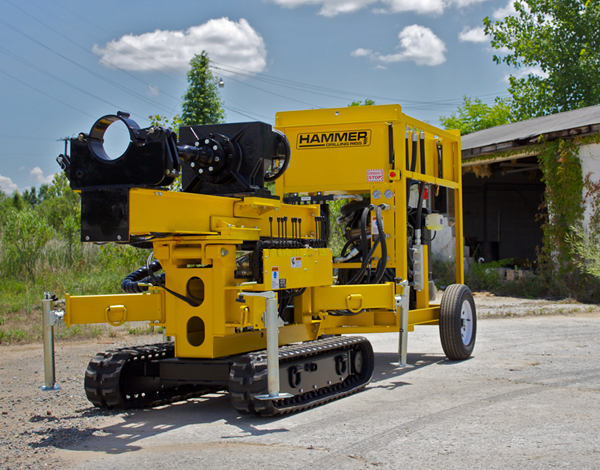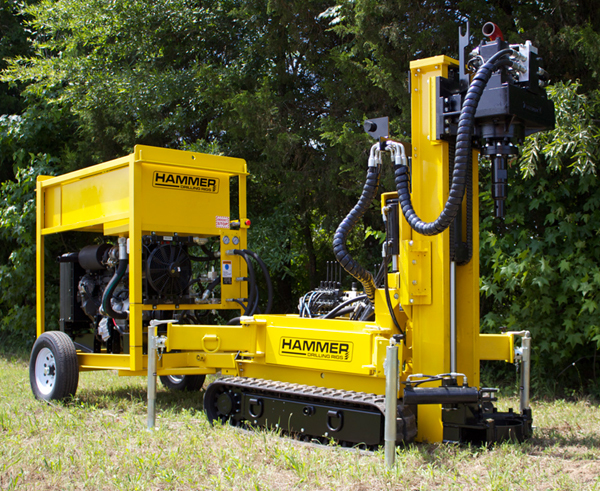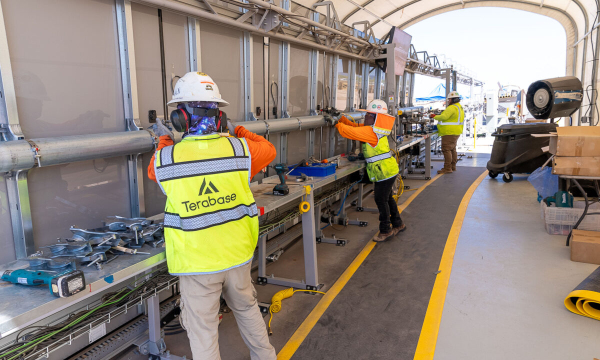By Brandon Wronski, Special To Solar Power World
Cost reduction is at the top of the priority list for manufacturers, installers, contractors and consumers alike. Especially is this true in renewable energy markets. Lowering installation costs decreases the overall cost of the project and means a more level playing field with fossil fuel competition.
This ultimately amounts to greater consumer growth and increased sustainability. Unfortunately many costs and variables are beyond the contractor’s control. For example, site conditions generally dictate roof or ground mounting options. Roof mounts can be limited by the size, angle and direction of the roof and the increased degree of danger usually means an increased cost in installation. On the other hand, if there is inadequate land area, ground mounted arrays are out of the question.
However, if sufficient and suitable land area is available, ground mounting can be the best option. While many developers agree that prime farmland should not be used for solar, in many cases solar arrays can be located on brownfields without environmental impact.
Some companies also produce mounting systems that can be set above grazing space for animals. Ground mounts are not restricted by the size, angle and direction as can be the case with roof mounting. And ground-mounted arrays can be easily maintained. So there are choices that are within the contractor’s control. Efficiency can be optimized and costs reduced by making the right decisions.
If the decision is ground mounting, next come choices in regards to anchoring the racking to support the solar arrays. A crucial step is to perform a geotechnical site investigation to confirm subsurface conditions and assess the site’s potential installation options. This ensures that time and money is not wasted through trial and error.
Racking manufacturers usually stipulate general specifications that must be met based on the site conditions, such as soil type. Anchoring options include drilled shaft piles (also called micropiles or caissons) where the borehole is filled with high-strength cement grout or concrete, driven piles, and helical piers or ground screws that are twisted into the soil and remain in the ground.
Some contractors bidding on solar field installations subcontract out the drilling or turn down certain projects altogether. So, does the contractor have any control in this scenario? Is there a way of reducing the installation costs?

If the decision is ground mounting, next come choices in regards to anchoring the racking to support the solar arrays. A crucial step is to perform a geotechnical site investigation to confirm subsurface conditions and assess the site’s potential installation options. This ensures that time and money is not wasted through trial and error.
The solution could be to bring the drilling in house, but is that really a feasible option? Solar fields often require the drilling of thousands of piles, but the piles are relatively shallow, and the drilling is reasonably straightforward. Capital otherwise spent on contracting drillers could be invested in equipment and drill training, boosting the contractor’s bottom line.
Here again there are choices to be made and some very economical options available. A drill rig can be obtained new, used or possibly even rented. Many contractors already own and operate compact equipment such as skid steers, excavators, and the like. In this case a cost effective solution can be a drilling mast attachment.
As the mast and rotation head are powered by the carrier machine, capital costs can be reduced substantially if a suitable carrier machine is already owned. It should be noted though that a dedicated drill rig will be more mobile and efficient – more on that a bit later. “Build your own equipment” kits are another cost effective alternative for acquiring new drilling rigs, saving up to 40 percent on the capital cost of the rig. All major components such as the rotation head, crawler tracks and engine are shipped as pre-assembled components ready to bolt onto the steel frame.
The drilling method is another area where productivity can be greatly improved. The most efficient method is largely determined by the depth required and ground conditions. Instead of being at the mercy of drilling subcontractors, with education and training in basic drilling methods, contractors can then select the most productive process for each installation.
For example, loose materials and overburden can be drilled effectively with augers. In stable soils, standard continuous flight augers can be used to drill the borehole after which they are removed and the open borehole is filled with cement/grout. In less stable soil, hollow stem augers can be used to keep the hole open. The auger is then slowly extracted as concrete or grout is pumped through the center bore of the rotation head, and down through the hollow stem of the augers. DTH (down-the-hole) hammer drilling is highly efficient in rock formations.

The drilling method is another area where productivity can be greatly improved. The most efficient method is largely determined by the depth required and ground conditions. Instead of being at the mercy of drilling subcontractors, with education and training in basic drilling methods, contractors can then select the most productive process for each installation.
In suitable soils and with proper drilling equipment, helical piles offer substantial benefits including the exclusion of concrete, no curing time, immediate loading and even shorter installation depths – all of which can increase productivity considerably.
When it comes to drilling solar array anchors, versatility equals efficiency. A drill rig that has adequate torque to drill with augers or install helical piles, along with the ability to perform DTH hammer drilling, combined with the correct tooling means that the most efficient method can be employed. Additionally, as thousands of piles are often required, a compact, highly mobile rig is also important.
A lot of valuable time can be lost setting up and manoeuvring the rig for each hole. A rig with rubber tracks and lots mobility is crucial. Some drills have separate power units that can supply power up to 200 feet away, making the drill even more manoeuvrable. The choice of drill rig will directly affect the number of piles drilled per day, the cost of installation and therefore the overall cost of the entire project.
While some factors are out of the contractor’s hands, many are within reach. Reducing the installation costs of ground mounted solar arrays is possible with the right equipment and knowledge.
Brandon Wronski is sales executive at Hammer Drilling Rigs and a contributing writer at National Driller and Compact Equipment .
参考译文:
布兰登Wronski,专为太阳能发电
降低成本是在优先级列表的制造商,安装商,承包商和消费者的一致好评的顶部。尤其是,这是真的在可再生能源市场。降低安装成本降低了项目的整体成本,是指与化石燃料竞争,更公平的竞争环境。
这最终达至更大的消费增长和增加可持续性。不幸的是很多的成本和变量超出了承包商的控制。例如,场地条件一般规定屋顶或地面安装选项。车顶架可以由屋顶的尺寸,角度和方向,危险的增加程度是有限的,通常是指在安装成本的增加。另一方面,如果没有足够的土地面积,地面安装阵列是不可能的。
但是,如果有足够和合适的土地面积是可用的,地面的安装可以是最好的选择。虽然许多开发人员同意,基本农田不应被用于太阳能,在许多情况下,太阳能电池阵列可以位于棕地不受环境影响。
有些公司还生产出可以在上面放牧空间动物进行设置安装系统。地面坐骑不受尺寸,角度和方向限制,可以是具有屋顶的安装的情况。和安装在地面上的阵列可以容易地保持。因此,有选择是承包商的控制范围之内的。效率进行优化和成本降低做出正确的决策。
如果决定地面安装,接下来进来问候选择,以固定货架,支持太阳能电池阵列。一个关键步骤是进行岩土现场调查,确认地下条件,并评估该网站的潜在的安装选项。这确保了时间和金钱,不通过试验和错误浪费。
货架制造商通常规定,必须根据现场条件,如土壤类型满足一般规格。锚定的选项包括钻孔桩轴(也称微型桩或沉箱),其中钻孔填充高强度水泥浆或水泥,打入桩,并加捻到土壤和螺旋码头或接地螺钉留在地面上。
一些承包商在投标太阳能领域的安装分包出去的钻孔或拒绝某些项目完全。那么,承包商在这种情况下任何控制?是否有降低安装成本的一种方式?
如果决定地面安装,接下来进来问候选择,以固定货架,支持太阳能电池阵列。一个关键步骤是进行岩土现场调查,确认地下条件,并评估该网站的潜在的安装选项。这确保了时间和金钱,不通过试验和错误浪费。
如果决定地面安装,接下来进来问候选择,以固定货架,支持太阳能电池阵列。一个关键步骤是进行岩土现场调查,确认地下条件,并评估该网站的潜在的安装选项。这确保了时间和金钱,不通过试验和错误浪费。
该解决方案可以使家中的钻孔,但事实真的是一个可行的选择吗?太阳能领域往往需要数千桩的钻孔,但桩较浅,而钻井是相当简单的。资本,否则就承包钻井用了可以投资于设备和培训演练,提高承包商的底线。
这里再有选择的提出和一些非常经济的选项。 à钻机可以得到新的,使用甚至可能是租来的。许多承包商已经拥有并经营小型设备,如滑移装载机,挖掘机等。在这种情况下,具有成本效益的解决方案可以是钻桅附件。
作为桅杆和旋转头由载波机供电,资本成本可大幅降低,如果合适的载体中的机器已经拥有。应该指出的是,虽然专用钻机将是更多的移动和高效的 – 更多的是晚了一点。 “建立你自己的设备”包是另一种成本效益的替代获得新钻机,节省高达40%的钻井平台的资本成本。所有主要部件,如旋转头,履带和发动机被运送作为准备栓到钢架预装配组件。
该钻孔方法是另一个领域,生产率得以大幅度提高。最有效的方法在很大程度上取决于所要求的深度和地面条件决定。取而代之的是在钻井承包商,拥有教育和培训基础的钻探方法的怜悯,承包商可以再选择最有生产力的过程中为每个安装。
例如,松散的材料和覆盖层可有效地与螺旋推运器钻出。在稳定的土壤中,标准连续飞行螺旋装置可以用于钻,之后将被删除,打开钻孔填充水泥/砂浆的钻孔中。在不太稳定的土壤,空心阀杆螺旋装置可以被用来保持孔开放。螺旋推运器,然后慢慢地提取作为混凝土或水泥浆是通过旋转头的中心孔泵送,并且向下通过螺旋推运器的中空杆。 DTH(下中孔)锤钻在岩层高效。
该钻孔方法是另一个领域,生产率得以大幅度提高。最有效的方法在很大程度上取决于所要求的深度和地面条件决定。取而代之的是在钻井承包商,拥有教育和培训基础的钻探方法的怜悯,承包商可以再选择最有生产力的过程中为每个安装。
该钻孔方法是另一个领域,生产率得以大幅度提高。最有效的方法在很大程度上取决于所要求的深度和地面条件决定。取而代之的是在钻井承包商,拥有教育和培训基础的钻探方法的怜悯,承包商可以再选择最有生产力的过程中为每个安装。
在适宜的土壤和适当的钻井设备,螺旋桩提供了实实在在的好处,包括具体的排除,无固化时间,即刻负重,甚至更短的安装深度 – 所有这些都可以提高生产效率大大。
当涉及到钻井太阳能电池阵列锚,多功能性等同于效率。甲钻机具有足够的扭矩来钻与螺旋推运器或安装的螺旋桩,连同执行潜孔锤钻的能力,再加上正确的工具装置,最有效的方法都可以采用。此外,数以千计的桩往往需要一个紧凑,高度机动钻机也很重要。
很多宝贵的时间可能会丢失设置和操纵钻机的每一个孔。橡胶履带和大量的流动性装备是至关重要的。有些演习有独立的动力单元,可以提供功率高达200英尺的距离,使钻更机动性。钻机的选择将直接影响桩每天钻出的数量,安装的成本和整个项目,因此总成本。
虽然有些因素超出了承包商的手,很多都是触手可及。减少地面安装成本安装的太阳能电池板,可以用合适的设备和知识。
布兰登Wronski是销售主管,在锤钻机和特约撰稿人,在全国钻机和小型设备。













